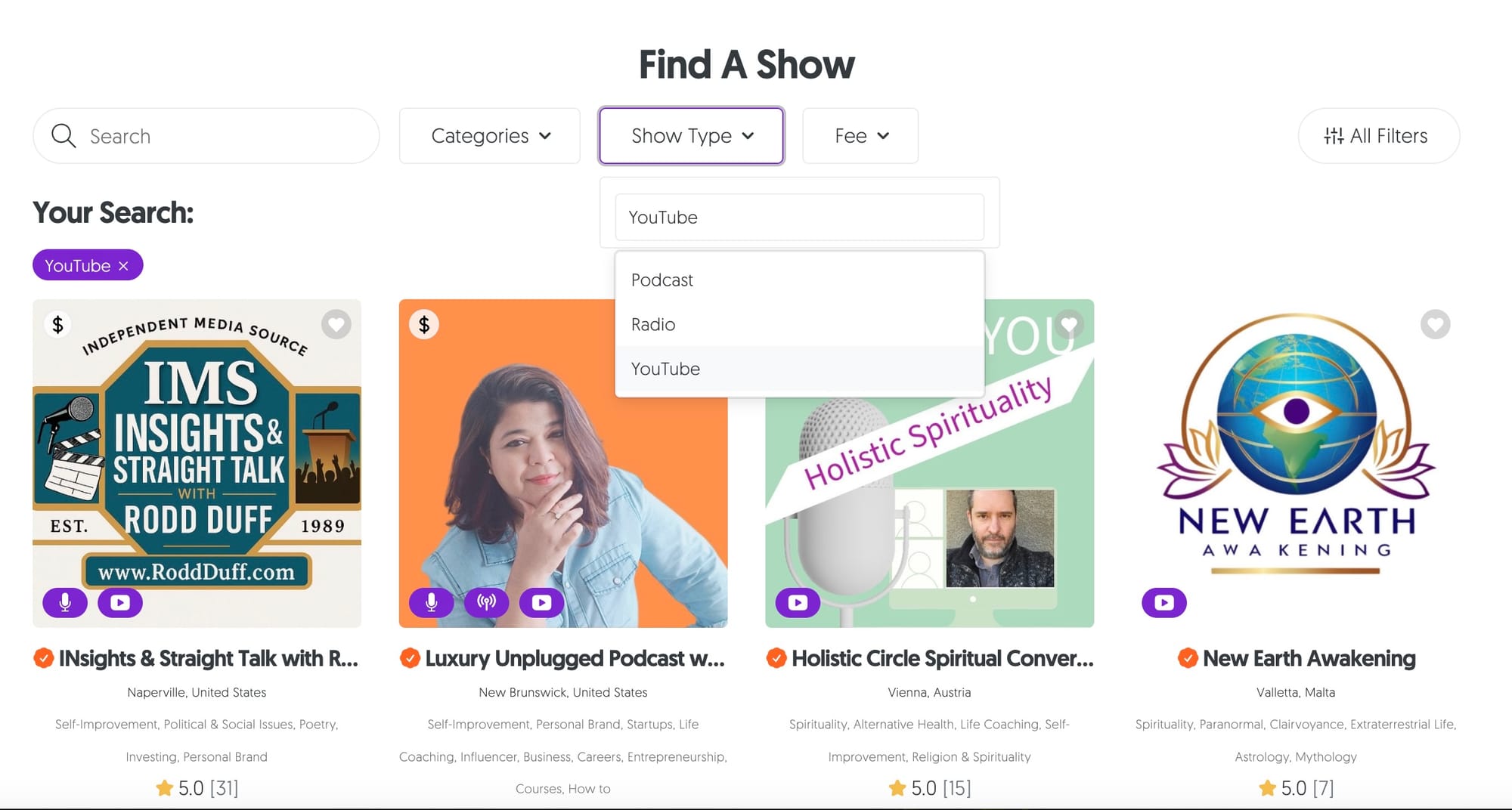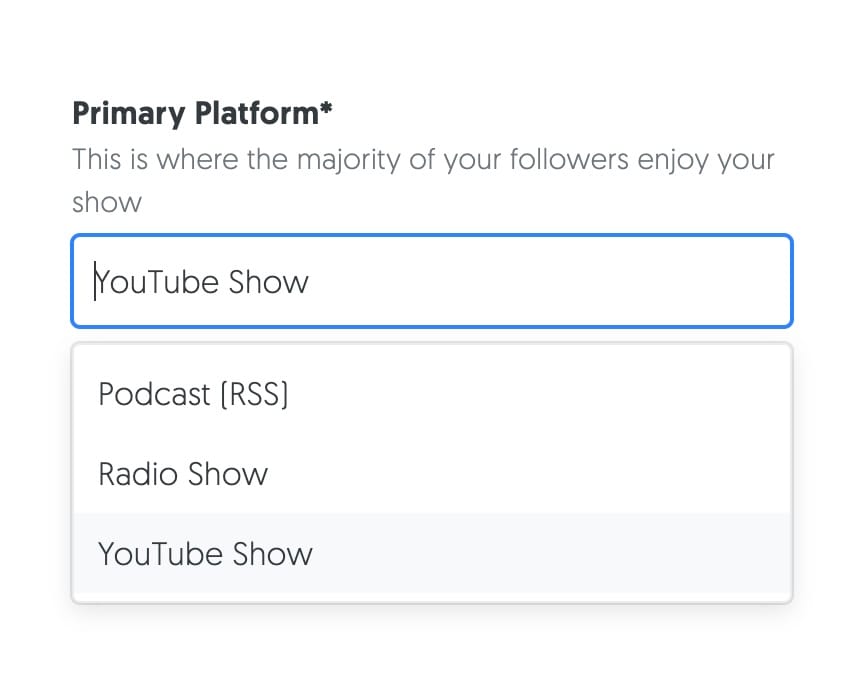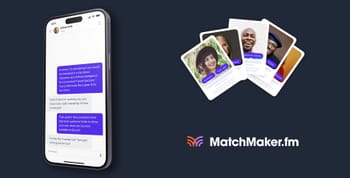In today’s digital landscape, creators are no longer confined to a single platform. YouTube channels, podcasts, livestreams, and digital events often overlap in audiences and formats, creating exciting opportunities for collaboration. By blending these worlds together and featuring unique guests, creators can reach new audiences, provide fresh perspectives, and improve the overall value of their content.
Matchmaker.fm now allows creators to filter searches specifically for YouTube, making it easier than ever to find collaborators suited to video content. This feature is especially useful for creators looking to expand beyond audio, identify the right guest for YouTube interviews or livestreams, and apply cross-channel content collaboration strategies.

Why Cross-Channel Collaboration Works
Collaboration works because it benefits everyone involved and can significantly amplify the impact of your content. When creators partner with guests across multiple platforms, they open up new avenues for audience growth. For example, a YouTube guest may introduce your podcast listeners to a new video format, while a podcast guest can bring devoted audio listeners to your YouTube channel. This cross-pollination not only diversifies your audience but also strengthens the connection between different communities.
Another reason cross-channel collaboration is effective is the variety it brings to your content. Each platform has its own style and expectations. Audio podcasts encourage deep, focused conversations, while YouTube videos often demand more visual storytelling and concise delivery. Guests who can move between these formats bring flexibility, allowing you to create content that feels fresh and engaging on multiple channels. Their unique insights or expertise can be tailored to fit each platform, keeping your content dynamic and relevant.
Collaboration also builds credibility and authority. A guest known in their field can lend trust and legitimacy to your channel or show, especially when audiences see them appear across different formats. When viewers or listeners encounter the same guest on multiple platforms, it reinforces their expertise and authority of your own content’s perceived value.
Finally, cross-channel collaboration can save time and effort in content creation. A single conversation with a guest can be repurposed into multiple formats: an audio podcast, a video interview, social media clips, and blog content. This approach ensures that each collaboration delivers maximum value, creating more touchpoints for engagement and allowing creators to maintain a consistent content schedule without overextending themselves.
- YouTube Meets Podcasts
Many podcasters are adapting their shows for YouTube, giving audiences the option to watch or listen. At the same time, YouTubers are branching into podcasts to reach listeners during moments when video isn’t practical, like driving or exercising. YouTube guests can move smoothly between these formats, giving creators the chance to share a single conversation across multiple platforms. - Guests Add Authority and New Voices
Inviting a YouTube guest or podcast guest can bring energy and credibility to a show. A YouTube interview can later be turned into an audio podcast episode, while a guest’s podcast appearance might be reshaped into short clips for social media or a YouTube highlight reel. Each appearance becomes a building block for fresh content. - Livestreams and Interactive Sessions
Livestreams on Twitch, LinkedIn Live, or YouTube Live add an interactive layer. Guests bring their own communities into the conversation, encouraging real-time engagement and creating connections between different audiences. - Digital Events and Communities
Collaboration extends beyond shows. Online summits, workshops, or membership communities all benefit from hosting special guest sessions. These appearances add variety and encourage ongoing interest from members or attendees.
The Differences Between Podcasts, YouTube Podcasts, and YouTube Channels
While all these platforms overlap in some ways, they each have unique strengths and approaches when it comes to guests.

- Podcasts (Audio-First Format):
Podcasts focus on audio, making them ideal for people who want to listen while multitasking. Podcast guests often share detailed storytelling, personal experiences, or expert advice. The intimacy of audio creates a strong bond between guest and audience.

- YouTube Podcasts (Video + Audio Hybrid):
YouTube podcasts blend audio and video. They are similar to traditional podcasts but allow for visuals—body language, demonstrations, and expressions add depth. YouTube’s discovery tools also make it easier for new viewers to find episodes featuring your guests.

- General YouTube Channels (Video-First Content):
Not every YouTube creator runs a podcast. Many focus on tutorials, commentary, reviews, or entertainment. Guests on these channels might join in demonstrations, challenges, or panel-style discussions. While podcasts are often longer conversations, YouTube videos are usually shorter and more visual. Guests help introduce new subjects and styles to keep the channel fresh.
Real-World Collaboration Scenarios
- YouTuber Expands with a Podcast:
A tech reviewer on YouTube invites an industry expert as a guest. They record a YouTube interview and simultaneously produce an audio version for a podcast. The guest shares the episode with their network, bringing new viewers and listeners to the YouTuber’s channel and podcast. - Podcaster Goes Visual:
A fitness podcast host records a conversation with a guest trainer. They post the full interview on YouTube, and then break it into shorter clips for social media. Viewers who discover the YouTube clips are encouraged to listen to the full podcast for deeper insights. - Live Event Integration:
A creator runs a livestream Q&A featuring multiple YouTube guests and podcast guests. The interactive session is recorded, later repurposed as a podcast episode and a YouTube highlight reel, providing ongoing content across platforms. - Community Building:
A membership platform hosts a digital summit with several guest speakers who are also active YouTubers and podcasters. The summit sessions are recorded and shared across channels, creating a library of collaborative content that benefits both creators and their audiences.
Making Collaboration Work

- Choose the right guests:
Find people whose expertise or personality fits your audience. - Repurpose the content:
A single conversation can become a podcast episode, a YouTube video, a short clip, or a blog post. - Promote across platforms:
Encourage both creators and guests to share the content, helping each side reach new audiences. - Think long term:
One-off collaborations help, but ongoing relationships with recurring guests can lead to bigger projects and lasting partnerships.
How To Search For YouTube on MatchMaker.fm
MatchMaker.fm has long supported YouTube channels, and this is how you can take full advantage of this feature:
- Discovering YouTube Shows as a Guest:
Guests can now search for YouTube shows when looking for new opportunities. In addition, MatchMaker.fm will recommend relevant YouTube shows in your weekly matches, making it easier to connect with creators who are actively seeking collaborations.

- Adding Your YouTube Show:
Add your YouTube channel either as a separate show or to your existing show profile, marking it as a primary or secondary platform. This allows you to start matching with suitable guests specifically interested in video collaborations.

This is one simple way to align with other creators and maximize exposure across multiple platforms, reaping the benefits of cross-channel collaboration!
Bridging The Gap

Cross-channel collaboration is one of the strongest ways for creators to grow. Mixing YouTube guests, podcast guests, general YouTube videos, livestreams, and digital events creates opportunities to share conversations with wider audiences. Each platform offers its own strengths, and when combined, creators can connect with viewers and listeners in multiple ways.
Guests play a key role by bringing credibility, variety, and new ideas. When content is repurposed across platforms, a single appearance can provide weeks of engaging material. Real-world examples show how creators can expand their reach and diversify content by combining formats and sharing guest appearances.
Tools like MatchMaker simplify this process. By allowing creators to filter specifically for YouTube guests, it becomes easier to identify the right collaborators for your content. The platform helps creators of all types—podcasts, YouTube channels, livestreams, and digital events—build meaningful collaborations that attract new audiences and strengthen relationships.
Collaboration is more than filling a guest spot. It’s about creating richer content, expanding reach, and establishing long-term connections. MatchMaker.fm helps creators turn these opportunities into practical, repeatable strategies for success.






